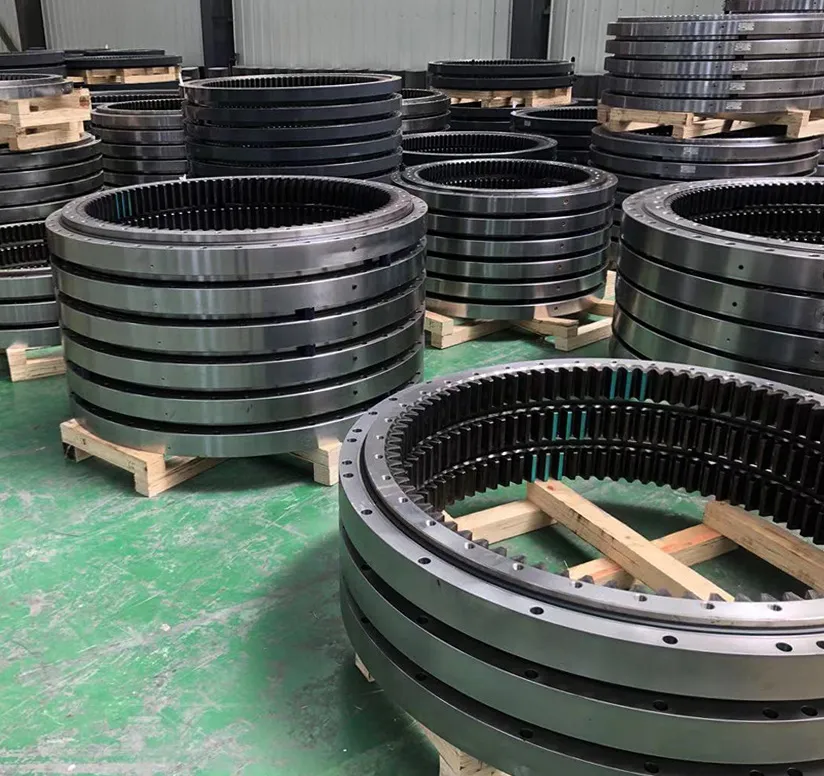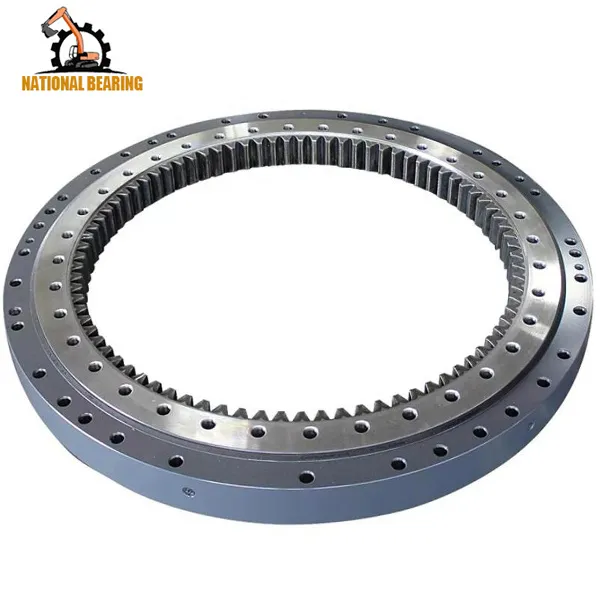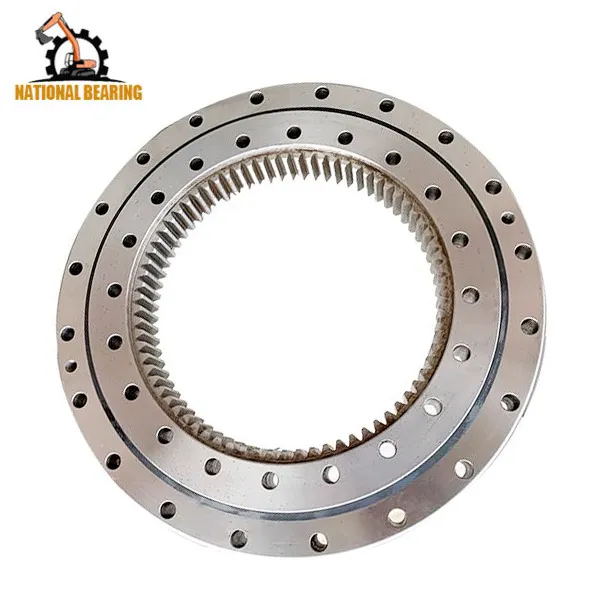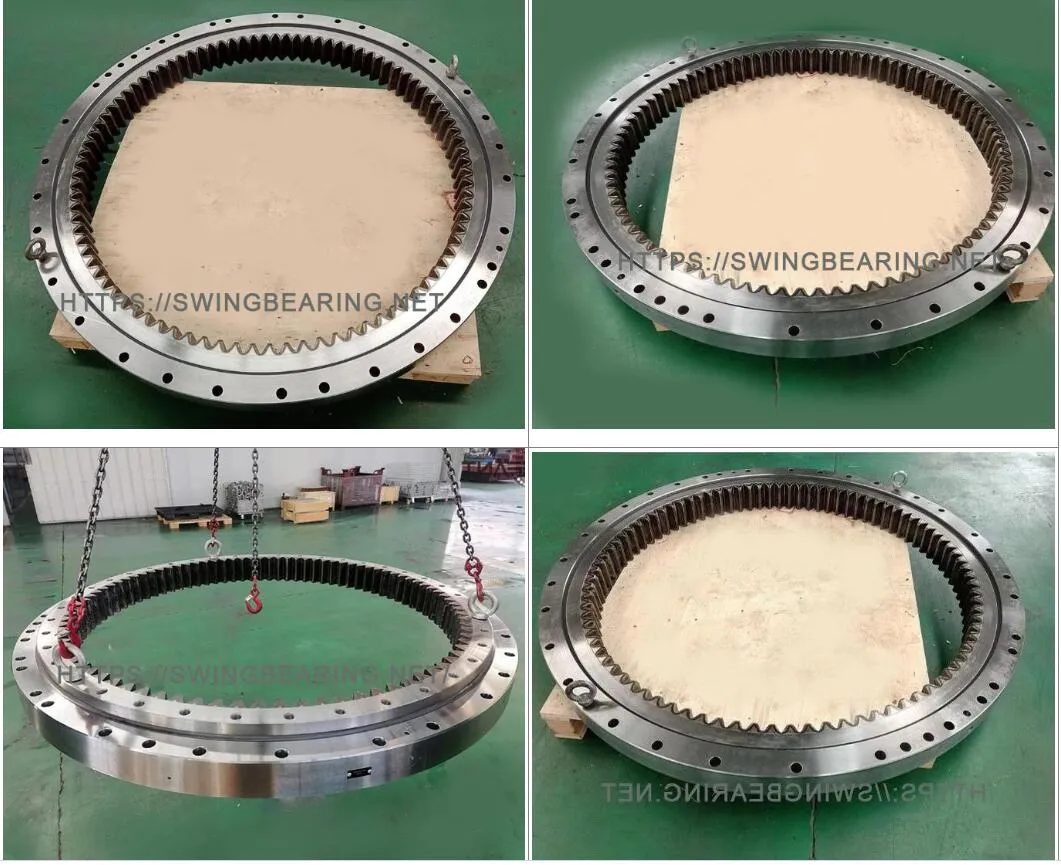
Swing bearings (slewing bearing)are versatile components used in various industries due to their ability to withstand high loads, accommodate misalignment, and provide smooth rotational motion. They find applications in:
Construction Equipment: Excavators, cranes, and bulldozers
Mining Machinery: Conveyors, crushers, and drilling rigs
Industrial Automation:Robotics, assembly lines, and packaging machinery
Wind Turbines: Yaw systems and blade pitch control
Marine Equipment:Cranes, winches, and deck machinery
Medical Devices: Surgical tables, imaging systems, and patient lifts
Aerospace:Landing gear, flight control systems, and aircraft engines

Slewing Bearings in Aerospace: Enhancing Aircraft Maneuverability and Stability
Slewing bearings play a pivotal role in various industries, including aerospace, where they contribute to the enhanced maneuverability and stability of aircraft. In this sector, swing bearings are primarily utilized in flight control systems, enabling smooth and precise movement of control surfaces such as ailerons, elevators, and rudders. These bearings facilitate the articulation of these surfaces, allowing for effective aircraft maneuvering and stability during flight.
Moving beyond aerospace, swing bearings find applications in the construction industry, where they are employed in cranes and other heavy machinery. These bearings enable the smooth rotation of crane booms and platforms, ensuring safe and efficient lifting operations. Their ability to withstand heavy loads and harsh environmental conditions makes them ideal for such demanding applications.
In the marine industry, swing bearings are essential components of ship steering systems. They facilitate the rotation of rudders, enabling precise vessel maneuvering and course correction. The ability of swing bearings to operate reliably in marine environments, where exposure to saltwater and corrosion is a concern, is crucial for ensuring safe and efficient ship navigation.
Furthermore, slewing bearings are utilized in wind turbines, where they support the rotation of the turbine blades. These bearings must withstand extreme weather conditions, including high winds and temperature fluctuations, while ensuring smooth and efficient blade movement. Their durability and reliability are essential for maximizing wind energy generation and minimizing downtime.
In the medical field, slewing bearings are employed in surgical robots, providing precise and controlled movement of surgical instruments. These bearings enable surgeons to perform complex procedures with enhanced accuracy and dexterity, leading to improved patient outcomes. The ability of slewing bearings to operate in sterile environments and withstand repeated sterilization cycles makes them well-suited for medical applications.
In conclusion, slewing bearings are versatile components that find applications in a wide range of industries, including aerospace, construction, marine, wind energy, and medical. Their ability to facilitate smooth and precise rotation, withstand heavy loads, and operate in challenging environments makes them essential for enhancing the performance and safety of various systems and machinery.

Excavator Swing Bearings
Slewing bearings play a pivotal role in various industries, enabling the smooth and efficient movement of heavy equipment. In the construction sector, swing bearings are indispensable components of excavators, cranes, and other machinery. These bearings facilitate the rotation of the upper structure relative to the undercarriage, allowing for precise positioning and maneuverability.
The robust design of slewing bearings ensures stability and durability in demanding construction environments. They withstand high loads and dynamic forces, enabling equipment to operate safely and efficiently. The ability to rotate smoothly reduces wear and tear on other components, extending the lifespan of the machinery.
In the mining industry, slewing bearings are crucial for the operation of excavators and draglines. These massive machines rely on swing bearings to rotate their booms and buckets, allowing for precise excavation and material handling. The bearings must be able to withstand extreme loads and harsh conditions, including dust, dirt, and moisture.
Slewing bearings also find applications in the agricultural sector. They are used in tractors, harvesters, and other equipment to facilitate steering and maneuvering. The ability to rotate the wheels independently allows for precise control and efficient operation in tight spaces.
Furthermore, slewing bearings are employed in the marine industry. They are used in cranes, winches, and other equipment on ships and offshore platforms. The bearings enable the smooth rotation of these components, ensuring safe and efficient operation in challenging marine environments.
The design and materials used in slewing bearings vary depending on the specific application. For heavy-duty applications, such as in construction and mining, bearings are typically made of high-strength steel or alloy materials. In lighter applications, such as in agriculture and marine environments, bearings may be made of aluminum or composite materials.
Proper maintenance and lubrication are essential to ensure the longevity and performance of slewing bearings. Regular inspections and timely replacement of worn components can prevent costly breakdowns and downtime. By adhering to recommended maintenance schedules, operators can maximize the lifespan of their equipment and ensure its continued safe and efficient operation.
In conclusion, swing bearings are versatile components that play a critical role in various industries. Their ability to facilitate smooth rotation, withstand high loads, and operate in demanding environments makes them indispensable for heavy equipment and machinery. Proper maintenance and lubrication are essential to ensure the optimal performance and longevity of these bearings, contributing to the efficiency and safety of operations across a wide range of industries.
Swing bearings play a crucial role in various industries, enabling precise and flexible motion in automated systems. In robotics, swing bearings are essential components that facilitate the smooth and accurate movement of robotic arms and other articulated structures. These bearings allow for rotational motion in multiple planes, providing robots with the dexterity and flexibility required for complex tasks.
In the construction industry, swing bearings are utilized in cranes and other heavy machinery. They enable the smooth rotation of the crane’s boom, allowing for precise positioning of loads. Additionally, swing bearings are employed in wind turbines, facilitating the rotation of the turbine blades to capture wind energy efficiently.
The automotive industry also benefits from the use of swing bearings. They are incorporated into steering systems, enabling smooth and responsive steering control. Swing bearings are also found in suspension systems, providing flexibility and stability during vehicle movement.
In the aerospace sector, slewing bearings are critical components in aircraft control systems. They allow for precise and reliable actuation of flight control surfaces, ensuring the aircraft’s stability and maneuverability. Similarly, in the medical industry, swing bearings are used in surgical robots, providing surgeons with enhanced precision and control during minimally invasive procedures.
The versatility of swing bearings extends to the agricultural industry as well. They are employed in irrigation systems, enabling the precise rotation of sprinklers to ensure optimal water distribution. Swing bearings are also found in harvesting equipment, facilitating the smooth and efficient movement of cutting and collecting mechanisms.
The design and materials used in slewing bearings vary depending on the specific application. For high-load applications, such as in construction and heavy machinery, robust bearings with durable materials are required. In contrast, applications in robotics and medical devices demand bearings with low friction and high precision.
Overall, slewing bearings are indispensable components in a wide range of industries, enabling precise and flexible motion in automated systems. Their versatility and adaptability make them essential for applications where accuracy, reliability, and durability are paramount.
What are the applications of slewing bearings in the construction industry?
Swing bearings are used in cranes, excavators, and other heavy machinery to provide smooth rotation and support heavy loads.
How are slewing bearings utilized in the wind energy sector?
Swing bearings are used in wind turbines to support the rotor and allow it to rotate smoothly, enabling efficient power generation.
What are the advantages of using swing bearings in the marine industry?
Swing bearings are used in marine applications such as ship cranes and offshore platforms to provide stability, reduce friction, and handle heavy loads in harsh environments.

Swing bearings find widespread applications across various industries due to their unique design and versatility. Their ability to accommodate high axial and radial loads, combined with their compact size and low maintenance requirements, makes them an ideal solution for a range of applications.
In the construction industry, swing bearings are used in cranes, excavators, and other heavy machinery to provide smooth and precise movement. They enable these machines to lift and rotate heavy loads with ease, ensuring safety and efficiency.
In the automotive industry, swing bearings are employed in steering systems, suspension components, and driveline applications. They contribute to improved handling, stability, and durability of vehicles.
Within the aerospace sector, swing bearings are utilized in aircraft landing gear, flight control systems, and engine mounts. Their ability to withstand extreme loads and harsh environments makes them essential for ensuring the safety and reliability of aircraft.
In the renewable energy industry, swing bearings are used in wind turbines and solar tracking systems. They facilitate the smooth rotation of these systems, maximizing energy generation efficiency.
Furthermore, swing bearings find applications in medical equipment, robotics, and other specialized industries. Their compact size, low friction, and high precision make them suitable for applications where space is limited and precise movement is crucial.
In summary, swing bearings play a vital role in a diverse range of industries, enabling efficient and reliable operation of machinery and equipment. Their unique design and versatility make them an indispensable component in various applications, from heavy construction to aerospace and renewable energy.